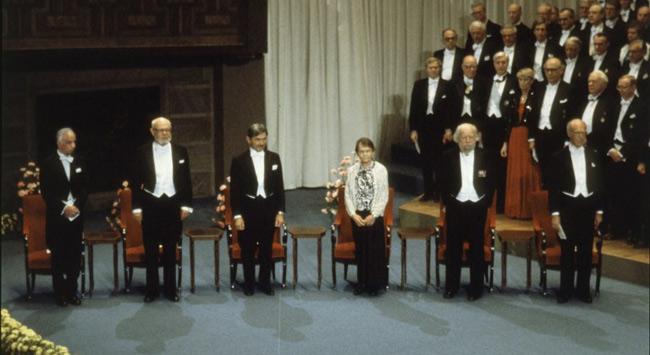On the death anniversary of Subrahmanyan Chandrasekhar, one of the greatest scientists of the 20th century, a look at the life and work of this Indian-American astrophysicist
Subrahmanyan Chandrasekhar, the Indian-American astrophysicist, was awarded the 1983 Nobel Prize for Physics along with William A. Fowler, for his mathematical theory of black holes, which was a key discovery that led to the currently accepted theory on the evolutionary stages of massive stars.
ADVERTISEMENT

Subrahmanyan Chandrasekhar and William Fowler (from L to R) in Stockholm during the Nobel prizes ceremony on 10 December 1983. Pic/AFP
Born on 19 October, 1910 in Lahore (now in Pakistan) to a Tamil family, he was educated at Presidency College, at the University of Madras from 1925 to 1930 and at Trinity College, Cambridge.
He was the nephew of Sir Chandrasekhara Venkata Raman (CV Raman), who won the Nobel Prize for Physics in 1930.
The Chandrasekhar limit is named after him. According to which, a star having a mass more than 1.44 times that of the sun does not form a white dwarf but instead continues to collapse, blows off its gaseous envelope in a supernova explosion, and becomes a neutron star. An even more massive star continues to collapse and becomes a black hole. These calculations added to the eventual understanding of supernovas, neutron stars, and black holes.
In diverse periods he worked in various areas, including stellar structure, stellar dynamics, theory of radiative transfer, quantum theory of the negative ion of Hydrogen, hydrodynamic and hydromagnetic stability, equilibrium, general relativity, and theory of colliding gravitational waves.
Chandrasekhar married Lalitha Doraiswamy in September 1936. They met as fellow students at Presidency College, Madras.
He joined the staff of University of Chicago as assistant professor of astrophysics (1938) and later as Morton D. Hull distinguished service professor of astrophysics (1952). He mostly lived and worked abroad and in 1953 he became a US citizen. However, he was deeply concerned with India's well-being. He had strong association with many scientific institutions and young scientists in India.
From the year 1952 to 1971 Chandrasekhar was editor of The Astrophysical Journal. He was awarded the Gold Medal of the Royal Astronomical Society in 1953 and the Royal Medal of the Royal Society in 1962.
He died of a sudden heart attack at the University of Chicago Hospital on August 21, 1995.
 Subscribe today by clicking the link and stay updated with the latest news!" Click here!
Subscribe today by clicking the link and stay updated with the latest news!" Click here!






